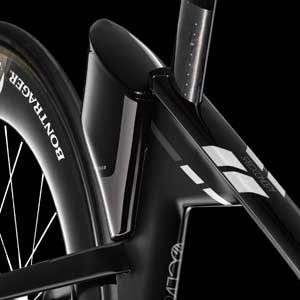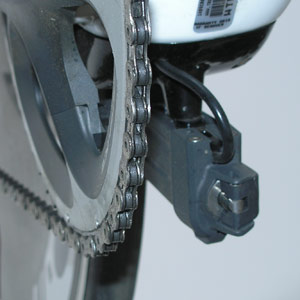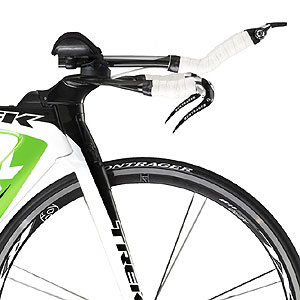Speed Concept Makeover

What do you do when, as a bike engineer, you produce your best effort, yet you still have to incrementally improve your best effort every so often? In the case of Cervelo and Trek you launch your old product just like a new product, with updates robust enough – hopefully – to warrant a relaunch.
In Cervelo’s case, with the new P3, yes, it was a wholesale change in the product. New frame geometry, new molds, entirely new braking system, the new P3 was like the old P3 only if you stood at 10 paces; once you got close it was very exciting, newsy, and worthy of a relaunch. What about the new Speed Concept?
No, it’s not as “new” as the new P3. It’s pretty much built around the same chassis, same ideas, same fit theme, same narratives. But if you consider what it is that made the Speed Concept good, as well as what made it very frustrating, what needed changing and what didn’t, Speed Concept fans (and even more so Speed Concept retailers!) have a lot to cheer about.
Aerodynamics
No launch is complete unless a white paper attends it. Yes, there’s a white paper here which will download as a pdf if you want to see it. There is a lot of information on aerodynamics and what I found most notable is Trek’s finding, through the use of its own bike anemometer proboscis (a thing sticking way out in front of the bike, during testing, for wind gauge purposes), and the use of the slicker-yet Alphamantis technology (Trek was an early Alphamantis adopter), Trek decided that, at speeds between 18mph and 25mph, an average yaw angle was found to be 10.6°, based on results on courses at Ironman Arizona, Wisconsln and in Kona. They therefore focus attention to yaw angles between 7.5° and 12.5° yaw.

What you find is, according to Trek, the new Speed Concept is pretty much even with Cervelo’s P5, and slightly better than the original Speed Concept. They say the new version is about a minute-and-a-half quicker than the old over an Ironman distance bike leg, almost double that if you bolt on all appendages that turn your bike into a pack mule (which is actually necessary for semi-supported 112 mile rides). Still, if the unadorned SC is just 1 to 2 minutes faster over an Ironman bike leg, that’s not that much, unless you’re at the pointy end of the race. But this just speaks to how good the original SC was.
Part of the credit for the slight increase in aero performance over an already very slippery bike is given to larger gussets, which are the tube joining areas. Trek calls them “fillets” because in the old days round tubed steel bikes were “fillet brazed,” if they were made without lugs, and these “fillets” were the area where a lot of brass or silver built up the joint, and gave it a smooth appearance.
Part of the credit is given to the fork redesign and I’m guessing this is the largest source of whatever increase there is in the aero performance of this frameset. It has been my observation that you get a bigger aero bang for your redesign buck when you mess around with fork shapes, and how the fork interacts with the wheel.

Bolt-ons
Trek made a lot of correct decisions when it first conceived of an engineered the Speed Concept back for its original 2010 launch. One good decision was to focus on the extraneous stuff everybody needs to put on their bikes, but that no bike company ever pays attention to. For example, electronics. Most bike companies adopt a “that’s not my job,” mentality, like they’re restaurant waiters asked to bus a table. Well, okay, but the table needs busing, and the customer doesn’t care whether it’s the waiter or the busboy who does it. If the customer wants to know how fast he’s going, and how much power he’s producing; if he wants to put a spare tire and inflator on his bike; if he wants water bottles and food; and he wants to retain the promised aerodynamics of the bike, if the bike company says it’s not its job to keep the bike aero with food and water and electronics and spare tires aboard, then the rider will move to another solution.
Fortunately, Trek has a sister company, Bontrager, that can engineer and produce items that correspond with what Trek’s making as a bike company. Bontrager has done a terrific job of making these bolt-ons for Trek. Now, unhappily, Bontrager has not always done a good job downstreaming or leveraging its great partnership achievements on aftermarket products. Now that this updated Speed Concept’s aerobars are finished, will these new innovations downstream to Trek’s 7- and 2-Series Speed Concept bikes? So far, that hasn’t really happened; let’s hope that’s not the rule going forward. Well see when the 7-Series SC bikes are announced.

The Draft Box (the “trunk” on the back of the Speed Concept) got a little bigger, which is good, because it wasn’t always possible to stick everything you needed back there. Especially if you were riding tubular tires, especially if you wanted not only to change your tubie but put air in it.
Trek has a pair of new bolt-ons that focus on hydration: a between-the-bars bottle and a behind-the-saddle cage holder. The front bottle holder seems to be a riff off of Profile Design’s excellent Aero HC. But Trek has changed its aerobar system, now featuring a “mono” extension. There’s a pair of bosses on that mono-extension – one boss forward and one behind the aerobar pad cross-piece (a pad wing they call it) – that allows for a cage to be placed. It seems to me these newer generation cages made just for triathletes – Profile’s cage that’s part of it’s Aero HC system, and Bontrager’s RXL Tri Carbon Computer Cage for both a computer head unit mount and an aero bottle – would work fine on this new mono-extension.
The rear bottle system is reminiscent of other systems in the past that were part rear fairing, part bottle holder. It seems like a nice attempt, and Trek says it’s actually more aero than nothing back there at all. Confirming tunnel studies decades ago by John Cobb and Steve Hed, Trek’s data on this seems to suggest get those bottles low or, at least, not too high. (Plus, it’s hard to hike your leg over a bike that has bottles sticking up behind the saddle!) I just don’t like bottles back there at all, so, I’m not the right guy to write about a behind-the-saddle bottle holder.
Brakes
The brakes on this bike are proprietary, and, yes, they stop the bike nicely (as opposed to, say, Cannondale’s Slice RS proprietary brakes, which really did not do that job so well). Stopping on a tri bike, what’s the bike deal? It is a big deal. If you don’t have to begin decelerating until closer to a turn, while some other guy has to put the brakes on considerably earlier in order to get the bike stopped in time, that’s a LOT of time you gained on your competitor. The Speed Concept’s brakes always worked well, going back to the first launch of this bike.
But oh, baby, that rear brake was a pain in the arse to adjust. This is especially the case if we’re talking about changing pad width, and Trek had this nasty habit of not spec'ing an OE training wheel that was anything close to the rim width of the race wheels we all use.

My solution on the original Speed Concept? I spit-canned the Bontrager wheels that came OE on the bike and replaced them with wheels built around HED Belgium rims, so that my race wheels (HED Jet 60 in the front, Jet Disc in the rear) were the same brake pad width as the training wheels. Wheels-out, wheels-in.
Happily, Bontrager moved to 23mm rim widths between the first and second launches of its Speed Concept, so, no more of these 19mm and 20mm rims spec’d on this bike. The new Bontrager rims on the OE training wheels of this bike are the same width as the 23mm HED wheels I had custom built for my old SC.
The front brake adjustment system on the original SC was easier to use than the rear, and that rear system now works like the front, which means if you want to trim the pad – center the pad – it’s much easier now. You can do so with one of those tiny Allen wrenches (maybe a 2mm), and you don’t have to take off the cover and commence open-brake surgery, as you had to do on the old rear brake assembly. However, we do still have that problem of brake pad width. The only easy way to change brake pad width on this bike is to take off the brake pads, remove beveled washers from inside the brake caliper and place them on the outside of the caliper. This, for both the front and rear. A real pain in the arse, especially in the rear, where you have a clearance problem between the brake block bolt and the inside of the chainring. Not undo-able. Just painful.
My recommendation is for you to – at the point of purchase of this bike – mandate to the retailer that this bike be sold to you with wheels that have a braking surface width equal or close to equal to that of your race wheels. If it’s a set of HED Jets, like mine, no trouble: make sure your bike comes with a 23mm (which now comes stocked on the bike) or 25mm wide rim (that dimension measured at the point of the braking surface). If it’s a set of Reynolds with 20mm brake pad widths, have the wheels in your new SC swapped with another set of training wheels matching that. If it’s a Firecrest, HED is now making its Ardennes in 25mm. Fairly close match for your Firecrests.
It's only fair for me to mention that Carl Matson, the engineer most closely associated with this SC project, thinks I'm a ninny and that these brakes always adjusted in pad width well enough to accommodate varying rim brake surface widths.
Aerobars
This is the biggest change between the old and new Speed Concept, and there is one really big complaint I had about the old Speed Concept that has been fixed for this new iteration. It’s the pursuit position. It used to be way too swept forward. The new SC has this pursuit position placed 30mm rearward, and this is big. The very first thing I asked this bike’s engineer when I found out about a new SC iteration was: “Did you fix the pursuit position?” He did. Thank you.
Because of the new mono-extension, you can't just move the extensions fore and aft as you used to do on the old SC. This is not how you make the bike’s cockpit extend or retract. Rather, you have 4 sets of bolt holes in this extension, and the placement of the extension in one of these pairs of bolt holes determines cockpit length (well, along with the various stems available, as was the case in the original SC). Do you lose any fore/aft functionality because – for example – you’re dealing with 1cm increments rather than infinite increments? I don't know yet, I haven't fiddled with it. Trek says no. But even if the answer is marginally yes, that’s not really a problem.

Looking at the way the pads mount, they’re very like the 3T Aduro made for Cervelo’s P5. These companies borrow from each other, I’ve noticed. This “pad wing” is Trek’s homage to the Cervelo/3T superbike project, and the fit system Cervelo uses is a straight borrow from the Trek. Let’s talk about that fit system now.
Fit and Sizing
Slowtwitchers are familiar with one of the engineers on the SC project, Carl Matson, and Carl came up with a nifty way to get people to figure out which among these Speed Concepts they should fit aboard. This fit system, update for the new SC, is here. My complaint about this fit system is twofold: first, I would prefer x and y from the BB to the backs of the pads, not the center, and that’s what Zipp uses for its new Vuka Fit Software Tool. But that’s a minor detail.
My second complaint is more critical and it is that Carl gives our readers too much choice – he honors you a little too much. I’m going to commence work pretty soon on my own version this chart, and I’m going to take away choice. Choice is a good thing until it’s not, and what Carl offers readers here is the same problem we often see when we look at outputs for, say, the Guru Experience fit system’s list of usable bikes. Yes, true, I can be a 56cm, or 58cm bike. Maybe a 60cm. Each with different stem lengths and pitches. That’s too many options.
Better for me not to have to choose between a M, L or XL frame size for my new Speed Concept. Better for somebody just to tell me: size L, low/far stem, pad wing sitting on this pair of holes on this new SC’s mono-extension, and so on. I’m workin’ on that, I’ll tell you when I’m done.
That established, Trek as done more than any single bike company to make fitting onto superbikes easier. Also, the range of acceptable options seems to be somewhat tighter in this new spreadsheet versus the old one, so, maybe I'm criticizing overmuch, and should shut up until I use the new chart more.
Superbike Headaches
What Trek promises is that this bike gets built in half the time it took to build the old SC. “Build” meaning from the ground up, a bunch of parts, a frame, all on the floor. This is because there are fewer parts, Trek says, and I would imagine much of this is specific to the brakes and the aerobars. Really, it’s mostly the brakes that were a pain, so, nice for those who work on these bikes that it’s no longer like working on a 60’s era Jaguar E-type.
For Slowtwitchers who own superbikes, 60 percent say they’re very happy with them. Unquestionably happy. You probably don’t work on your bikes if you selected this when polled. Another 27 percent say they’re happy, but you report that these new bikes are a pain to adjust. The remainder, 13 percent of you, are so dissatisfied with the extra hassle working on superbikes, you say you'd be happier back with an unsuper bike. For this reason, I think Trek correctly focused most on what the new SC needed to do well as a superbike owned by us unsuper mortals.
Yes, if you read that white paper it’s all about the sex and sizzle of the aerodynamics. But this new SC has a seat binder mechanism that’s the old rear clamshell piece – 2 bolts – instead of that wedge piece in front of the seat post. Bravo! Much easier to mount brakes, especially in the rear. Much, much better pursuit position. Fewer parts and pieces in the aerobar, which I suspect makes this bar somewhat lighter. Fatter rim widths. The SC never needed to be more aero, but, fine, it’s more aero. What it really needed to was to be easier to work on, and for life outside the aero position to be easier for SC owners.
I’ll write more about the new Speed Concept after I’ve got some miles on it but, so far, fingers crossed, it seems like everything Trek really needed to do between the original SC and the new, it did.




Start the discussion at slowtwitch.northend.network